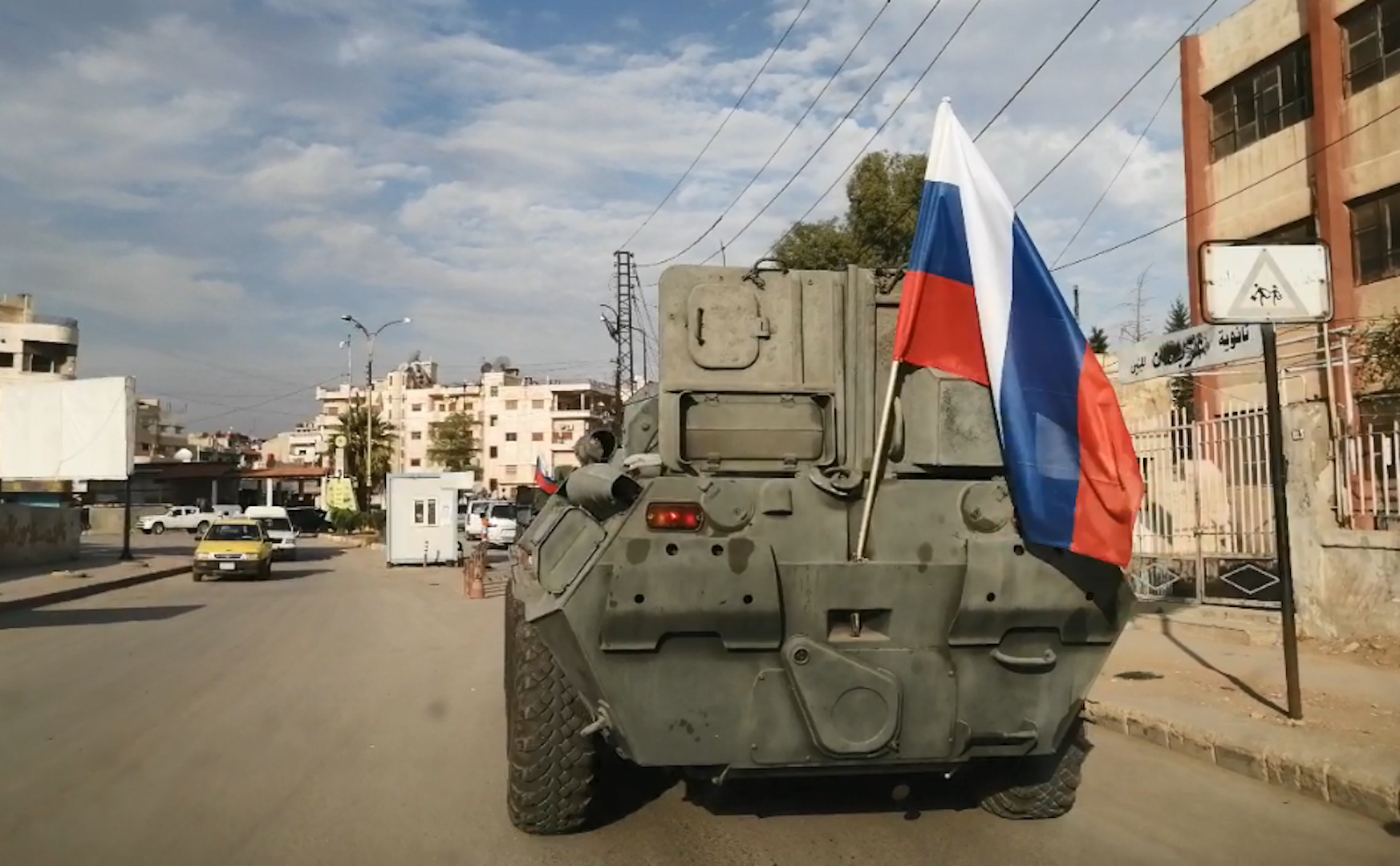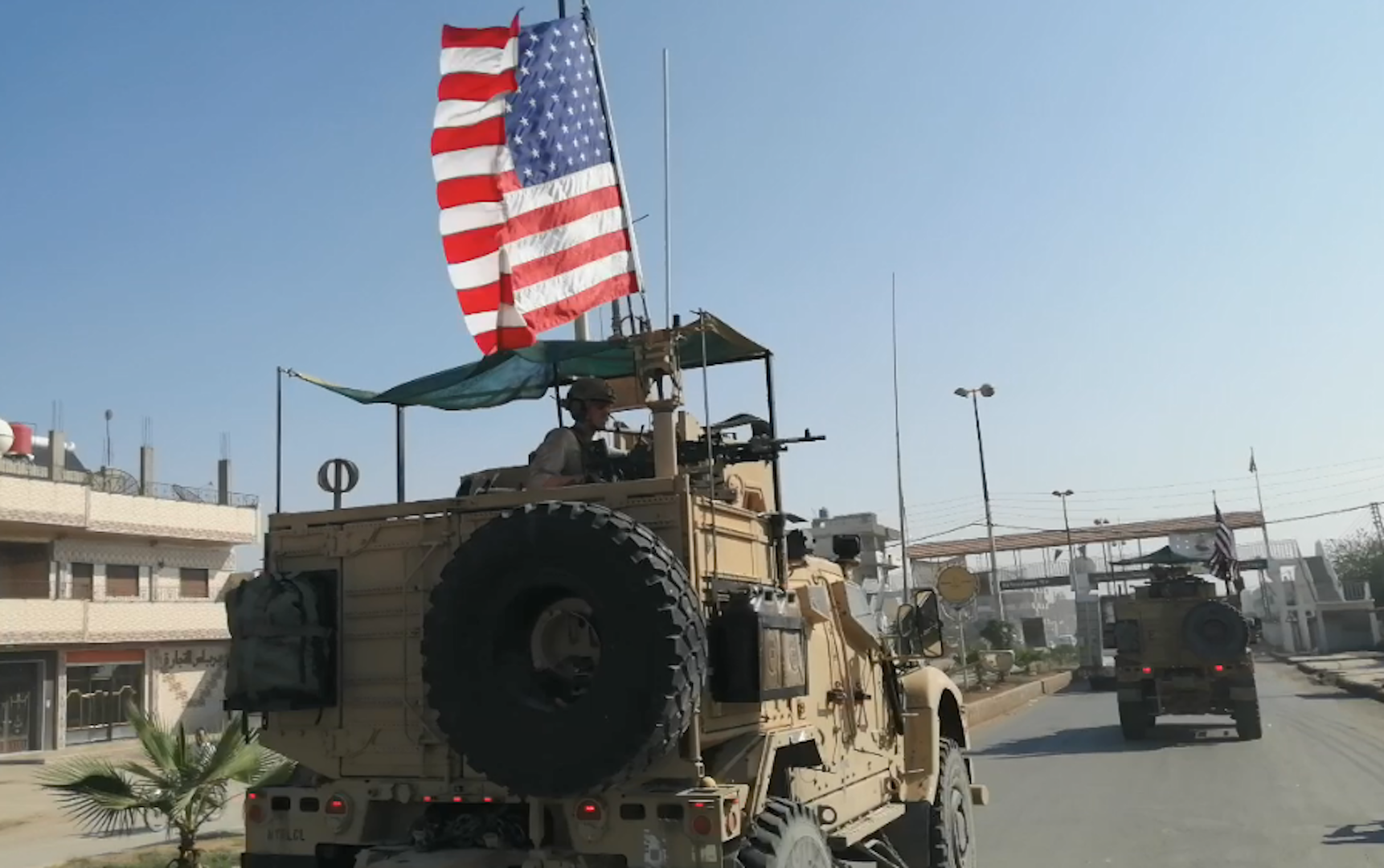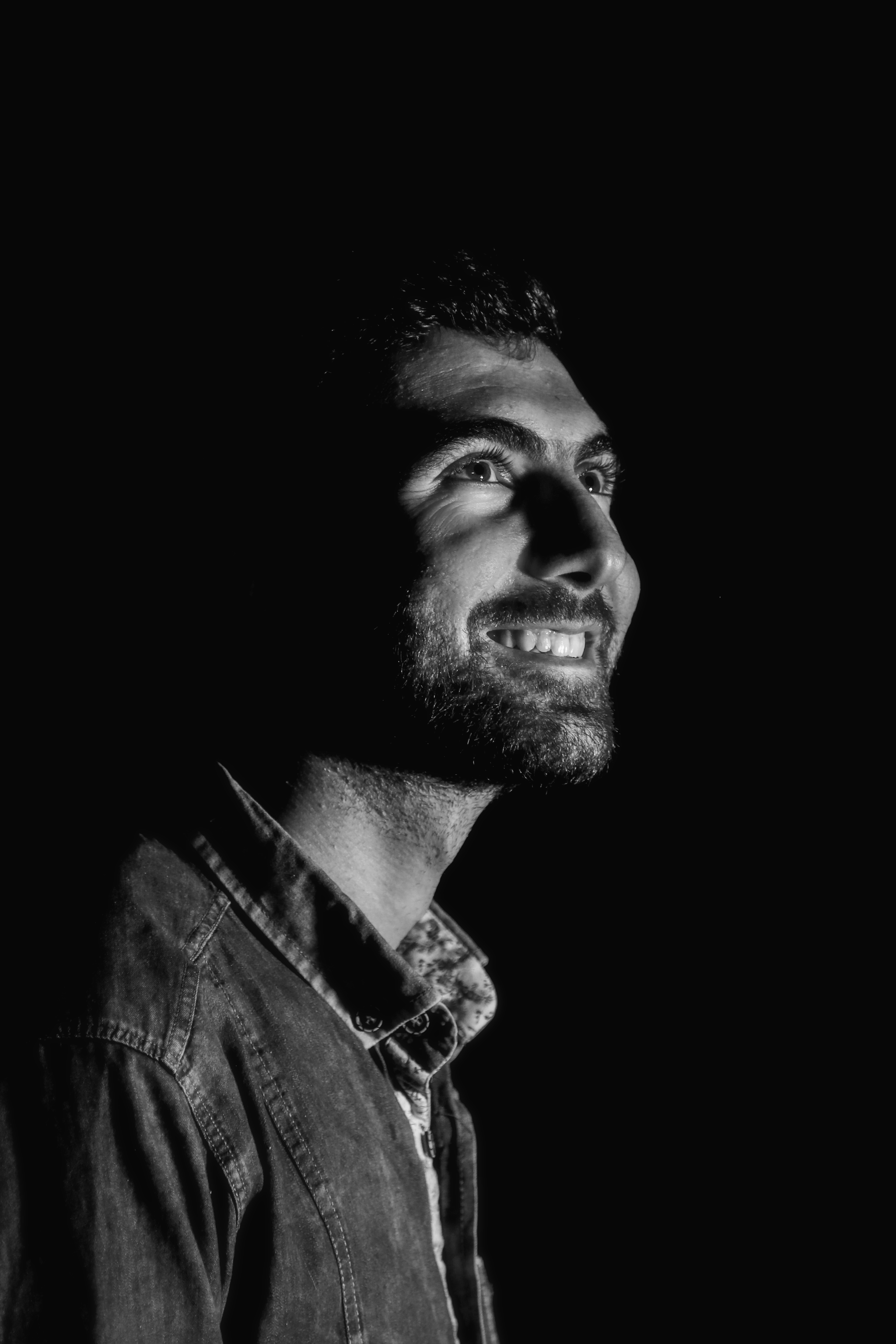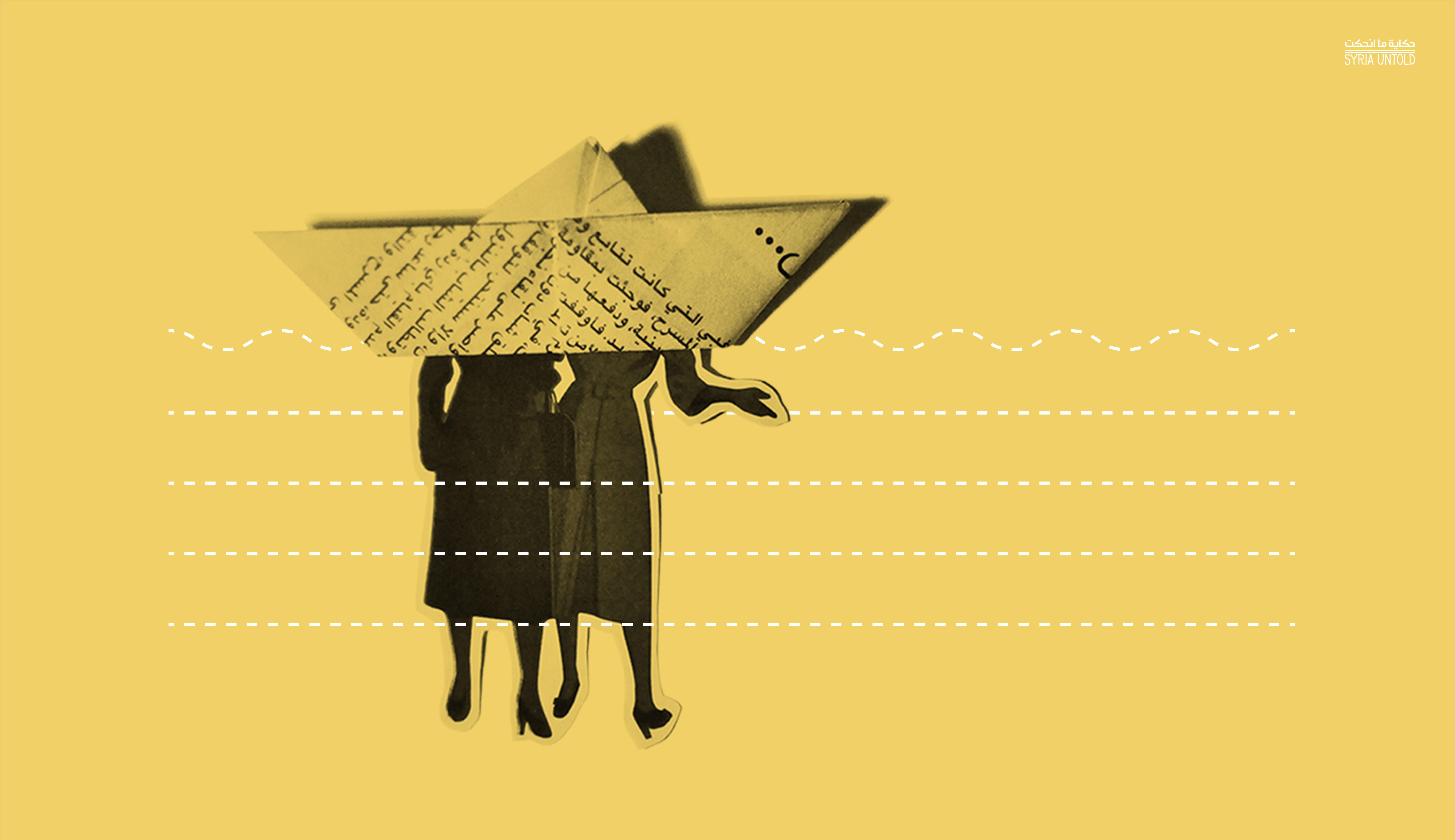This article is published as part of the "Syria In Depth" project, in collaboration and partnership with International Media Support, the Guardian Foundation and SyriaUntold.
QAMISHLI: Inside a café in Qamishli’s city center, Haj Amin sits beside a heater, hoping it might keep him warm during one of the freezing cold snaps that sweep this part of northeastern Syria during the early months of the year.
“I’ve felt this cold many times before, but I never imagined a day would come when I would see [foreign] troops coming all the way across the world to here,” says Haj Amin, who is in his 70s, rolling a cheap cigarette as he talks.
After years of war in Syria, the northeast of the country is now home to an array of different military forces—including US troops and Russian military police, who conduct patrols around Qamishli and regularly come to loggerheads with one another.
The presence of US forces leading the international coalition against the Islamic State (IS) dates back to the end of 2014—specifically, during the battle for northern Syria’s Kobane, where US-led forces rushed to the aid of the Kurdish People’s Protection Units (YPG) that would go on to form the backbone of the US-backed Syrian Democratic Forces (SDF).
This coordination culminated in the expulsion of IS from the city. With that, the US-led coalition began establishing military bases and barracks in different areas of northern and northeastern Syria—including in Qamishli.
Qamishli sits on a stretch of the Syrian-Turkish border in the far northeast of Syria. Built by the French in 1921, the city is inhabited by Arab, Kurdish and Syriac communities, with a total population of around 200,000 people. A number of residents are displaced Syrians from other areas of the country.
The SDF and the Syrian governmental share control of the city—the government controls an area known as the “security square,” which houses several security and military buildings. Even so, the SDF controls the largest part of the city.
But the map of Qamishli has only grown more complex. US forces had been the only foreign forces in Qamishli for years. But that isn’t the case anymore.
According to several informed sources speaking to SyriaUntold for this report, US forces in Qamishli mainly conduct intelligence activities focused on pursuing active IS cells in the area—and especially in territories previously under the hardline islamist group's control.
At a barracks in the western part of Qamishli, there are several soldiers, officers and other military and intelligence experts, however they halted 90 percent of their missions against IS in the wake of US President Donald Trump’s decision to withdraw in early October 2019.
According to informed sources, more recently the main mission of those stationed in the barracks has been to observe—and obstruct—the movements of Russian forces, who’ve been present in the same region since late last year.

Unexpected neighbours, rivals
In mid-October, Russian forces took up positions in Qamishli’s airport—four kilometers away from the nearest US forces’ locations.
The Russian intervention followed the signing of a memorandum of understanding between the SDF and the Syrian government, allowing the Syrian army to deploy along the Syrian-Turkish border. The agreement, which came in the wake of a Turkish-led military operation in northeastern Syria code-named Operation Peace Spring, also included joint military patrols to be conducted by Russian and Turkish military forces 10 kilometres within Syria but not in Qamishli.
Qamishli International Airport has since become a strategic focal point for Russian military police deployed to northeastern Syria.
Russian forces built a military base within the airport, installing advanced arms and radar tracking devices.
According to a military source working with the Russian forces, the base now hosts military police officers, medical personnel and helicopters that carry out repeated air sorties over the surrounding area.
During a visit to the airport, SyriaUntold saw what looked like a coordination chamber, inside which several Russian officers sat behind tracking devices. Maps hung from the walls. Photography was forbidden.

Why Qamishli?
US forces are present in many cities in northern Syria; the same applies to Russian forces as well. However, the only city to host both forces is Qamishli.
But why?
Journalist Alan Hassan, who is from Qamishli, talked about several factors encouraging each side to attempt to control the city and score points against the. Hassan said that the factors include “the city’s symbolism, as it encompasses a racial, religious and sectarian Syrian diversity.
“Besides, it is home to the security forces and Qamishli International Airport, and has a symbolic location in that it is adjacent to the Turkish city of Nusaybin, along the [Syrian-Turkish] border,” Hassan added. “It also boasts a strategic position close to oil-rich areas.”
Amr al-Dib, Moscow-based professor of international relations at Russia’s Nijni Novgorod University, agrees that Qamishli has “great importance because of its location in an oil-rich area as well as its remarkable agricultural significance."
“The US-Russian conflict over it is part of their wider conflict in the Middle East and other regions,” he told SyriaUntold.
Journalist Hadeel Oueis suggested that Qamishli represents a key territory from which Russia wants to expel the US. The US, meanwhile, wants to prevent a total regime takeover.
“One of the [Americans’] goals for remaining in northern Syria is to prevent the regime and Russia from tightening the noose on the area,” Oueis told SyriaUntold.

‘World war’ in a single city?
It’s perhaps unsurprising then that altercations between Russian and US forces have become an almost daily event.
In December last year, US and Russian soldiers ended up in a fist fight near the town of Tel Tamr, west of Qamishli, after US soldiers blocked the way of a Russian patrol. But there have also been altercations involving vehicles, roadblocks and other incidents.
Perhaps the most serious incident to date took place on February 12, when US forces shot dead a pro-government demonstrator in the village of Khirbet Amo, in the Qamishli countryside. Pro-government residents of the village had objected to the passage of a US patrol through Khirbet Amo. Notably, that many of those demonstrating against the US presence were volunteers in the ranks of National Defense Force (NDF) militias backed by the Syrian government.
Videos of Russian soldiers calling on the villagers to resist the US soldiers went viral on social media, as the crowd cheered, “Death to America, long live Russia!”
A clash later broke out.
The US-led coalition released a statement afterwards stating that its troops came under fire, and returned fire in order to defend themselves.
According to Kurdish journalist Hogir Najar, who was following the skirmishes closely, “Syrian regime forces supported the [NDF] militias and villagers in fighting the US patrol. Some militia members wore civilian clothes to appear innocent and fired live bullets at the patrol, in front of the Russian and Syrian forces.”
“Russia and the regime are trying to expel US forces from Syrian territories in order to tighten their grip over the whole area,” Najar told SyriaUntold, adding that he believes that Russian forces are trying to establish a Russian-affiliated force in the area to “target US forces.”
Imminent clash?
It is relatively rare that such altercations actually break out into violence. However, Russian and US forces have clashed before.
Late on February 17, 2018, troops from the Wagner Group, a private security firm with close links to the Kremlin which recruits fighters and sends them to various parts of the world, tried to advance on US and SDF-controlled areas east of the Euphrates River, seemingly in an attempt to seize the SDF-controlled Koniko gas field. US fighter jets and artillery, however, killed more than 300 of them, pushing back the attempted advance.
A source familiar with the US forces’ work in northeastern Syria confirmed that there were many other near-misses that could have led to a similar military clash between US and Russian forces.
According to the source, a Russian fighter jet penetrated US-controlled airspace east of the Euphrates in 2017, when the US was supporting the SDF in their fight against IS in the city of Tabqa.
“The commander in charge of the US forces called the Russian Coordination Center requesting that the fighter jet withdraw, but the Russians did not [withdraw],” the source told SyriaUntold. “Coalition forces began their preparations to shoot down the aircraft…[and] US forces were in a state of alert in several neighbouring countries.
“However, Russia made a decisive call that contained an apology and direct order to withdraw the jet.”
According to US-led coalition spokesperson Col. Myles Caggins, who spoke with SyriaUntold at a US base in the northeastern Syrian city of Rmelan, there are concerns about repeated altercations with Russian forces, however, channels for communication and de-escalation do exist.
“We are organizing our movements on the ground and in the air with local forces [referring to the SDF], and we are focusing our efforts to prevent any sudden escalation or confrontation.”
Caggins added that a mechanism has been set up to prevent engagement with Russian forces—especially on the M4 highway that runs through northeastern Syria between the Syrian-Iraqi border to the east and government-held Aleppo to the west.
There are exchanges of emails and phone calls with the Russians to avoid mistakes, Col. Caggins said.
At the same time, the common denominator between the US and Russian presence in Eastern Euphrates is their separate coordination with the SDF.
“Our coordination with the international coalition continues within the framework of the war against IS, and our coordination with Russia focuses on countering Turkish threats and achieving the border security mechanism,” SDF spokesperson Kino Gabriel told SyriaUntold.
“Our forces have the means and expertise to balance coordination with both [forces],” he added.

Damascus: ‘Brace yourselves for escalation'
The Syrian government, meanwhile, regards the presence of US forces as an occupation of sovereign Syrian territory.
SyriaUntold tried to contact a Syrian government official to comment on the presence of different forces on Syrian territory. A few days later, a military source in Hasakeh agreed to speak on strict condition of anonymity.
While the source described the presence of Russian forces in northeastern Syria as “legitimate,” largely because Russia’s intervention in the Syrian conflict in September 2015 followed an invitation to do so by authorities in Damascus, the same source went on to describe the US presence as “occupation.”
"There has been recent support for the formation of popular resistance groups to expel the occupying US and Turkish forces,” the military source said, adding that the Syrian army intends to reassert control, and raise the Syrian flag, over all territory currently outside the hands of Damascus.

‘Nobody is here for us’
Russian officials in northeastern Syria tend to avoid the media. However, after several attempts, and days of waiting for a response, SyriaUntold secured an interview with General Alexei Anatoly, the commander of Russian forces in the region east of the Euphrates River.
The general's facial expressions noticeably changed when asked about the presence of US forces in the region.
“The US is the cause of instability in the region, and it is the cause of the crisis in Syria,” Anatoly said, accusing US forces of betraying the Syrian people by giving a “green light” to Turkey to enter Ras al-Ain and Tal Abyad during last year’s offensive.
At the same time, disputes have not proved to be insurmountable. Anatoly confirmed that past incidents had all been resolved through diplomatic means.
Although, he added, “personally, I have never talked to them and will never [talk to them].”
Meanwhile, local residents fear the outbreak of yet another conflict in northeastern Syria—this time between clashing world powers that back different actors on the ground in the region. And local residents fear that they would ultimately be the victims of that conflict.
“The US-Russian conflict is over oil and gas and all resources in the region,” said Syriac poet Hana Sawmi. “We don’t accept the Russians or the Americans here. We want a free and liberated Syria.”
Bassel Abdi, a young Syrian man, does not hide his fears of a global conflict in his city and hopes it will be resolved through an international agreement—although he says he has more affinity to the US since it helped “expel IS from the city.”
Walking through a marketplace in central Qamishli, local resident Dlovan al-Sayed exclaims, “Let them both leave!”
“Russia sold us out in Afrin, and the US sold us out in Ras al-Ain. They both care about their interests only,” he added.
According to Leila Ahmed, who works at a local clothing store, “these repeated incidents stir up fears about a battle between [the Russians and Americans].”
“If that happens, God forbid, it will not be like the battles we’ve grown used to. They are world powers.”
However, she thinks there is still one silver lining for Qamishli—because it blocks Turkey’s way into the city.
She describes altercations between Russian and US forces as a “dispute between children from the same neighborhood,” even though neither have the interests of local communities at heart.
Haj Amin, still sitting there puffing away at his cigarette, agrees.
“Nobody is here for us. They all just care about their interests.”





